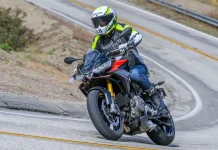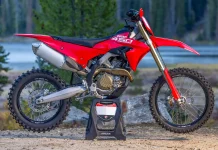
2011 GSX-R Reviews
The much anticipated revamped versions of the two smaller iconic Suzuki GSX-R 600 and GSX-R 750 have now arrived. Although the changes are somewhat subtle for 2011, they’re worthwhile, and in the supremely fast-moving Gixxer 600 segment of the market – the one dominated by racers and track day junkies – incremental changes are the difference between first and last place.
But don’t get the impression the Suzuki 600 wasn’t in first place in 2010. In AMA Daytona Sportbike – the premier national 600cc class Championship – the Suzuki 600 took 12 victories out of a total of 18 races in the highly capable hands of Martin Cardenas (nine wins) and Danny Eslick (three wins).
The difference between the 2011 Suzuki 600 and 750 Gixxers is only in the engine displacement; both chassis are identical. There were three principal objectives for the Suzuki engineers: 1) to Improve cornering performance by reducing the overall weight and shortening the wheelbase; 2) to improve braking performance with the use of Showa’s BPF (Big Piston Fork) and Brembo calipers; and 3) to improve acceleration by boosting the engine’s low-to-mid rpm range torque and using a close-ratio transmission.
Riding the two machines back to back around the beautiful Barber Motorsports Park in Alabama, I can safely say that Suzuki reached their goals. Both bikes handle superbly, turn-in positively and smoothly, hold their line well and then accelerate hard from the corners with strong, linear power.
Suzuki felt a reduction in wheelbase would aid cornering, however the existing 23-degree rake, 97mm trail, and swingarm length were ideal and it was decided to leave them unchanged. However, by rotating the engine backwards 3 degrees the frame length (and therefore wheelbase) was reduced by 15mm.
Although I’m sure this change must help the handling slightly, the overwhelming improvement was the weight reduction of 20 lbs. for the 600 and nearly 18 lbs. for the 750. This significant improvement is very noticeable, especially when changing direction at speed; both Gixxers are simply less physical to ride than before and perform absolutely intuitively.
Rider ergonomics were enhanced as well. The footpegs are now 3-position adjustable; the angle of each handlebar has been opened by 1 degree, and the shape of the fuel tank has been revised to help alleviate fatigue and improve handling.
The GSX-R retains the lowest seat height in its class at 31.8 inches and the slimmer seat has been redesigned for easier straddling and knee-gripping. Improved aerodynamics and simpler bodywork also reduce weight by 7.5 lbs and help with rider comfort and speed.
Both engines have received upgrades including a bump in compression ratio for the 600 to 12.9:1 and a change in cam profiles for both machines. Crankcase venting and redesigned, lighter pistons help engine responsiveness. Redesigned engine mapping, injectors, and exhaust system all play their part in boosting performance too.
The GSX-Rs now both come with two power modes, just A and B. These are changeable on the fly using the traditional headlight flasher button."‘A" mode allows full power, but "B" mode is considerably reduced with a noticeably soft power output and the motor takes its own sweet time to come on-song.
This was of limited value at the track, but before you scoff at the idea of limited power, consider how extremely useful it will be on the street on wet or slippery pavement. That it’s so easily switchable is a smart idea that will pay dividends in certain situations.
Big changes at the front are a very noticeable improvement. Showa’s Big Piston Fork (BPF) has been well-documented and now the Gixxer range gets it too. Not only does the Showa contribute to the overall weight reduction, but front-end feel and turn-in is noticeably enhanced. The BPF feels soft at first on initial application of the brakes, but quickly firms up in a positive, linear fashion as the fork compresses and rebound is well controlled so the chassis doesn’t get upset in mid-corner.
As a result my confidence in the front-end was always 100-percent and when grabbing a handful of brake at the end of Barber’s various straight sections, front-end dive felt controlled and kept the tire planted.
Turn-in was neutral and neither bike wandered, understeered or flopped into corners; each one felt very balanced. Both machines have an electronically controlled steering damper and over some of Barber’s more challenging elevation changes, front end wobble was quickly dissipated.
A Tokico radial master pump now bites down on Brembo Monobloc calipers at the front, and the difference when hot is noticeable. Initial bite is smooth and a little soft – very useful in emergency braking situations on the street – and on the track the broad range of feel was welcome when hard on the brakes.
I had to bring the lever out one click to prevent it pulling back to my hand, but once I’d adjusted it to my own taste I felt comfortable and confident in the brakes which were nothing short of superb.
Overall Suzuki has developed the GSX-R 600 and 750 into even more specialized track weapons, and yet they’ve managed to keep one eye out for the street rider as well. The 600 now has the best power-to-weight ratio in class and will no doubt be an even more formidable competitor this year in every class it enters. Its larger sibling is of course unique, as the only 750cc machine marketed today.
Although the 600 is a scalpel-sharp, perfect track-day weapon, the 750 is perhaps preferable for the street. A mere $400 separates the two in price, so the choice will be a difficult one. What a nice problem to have!





